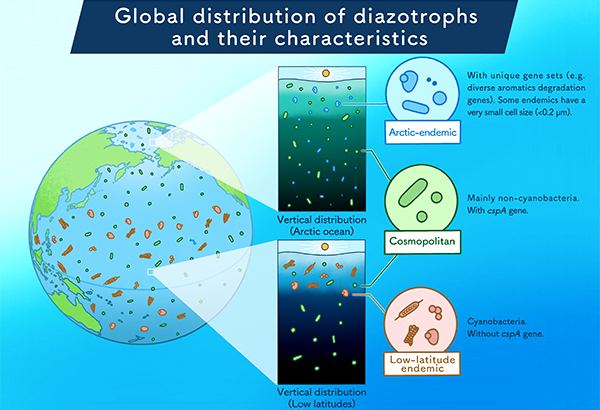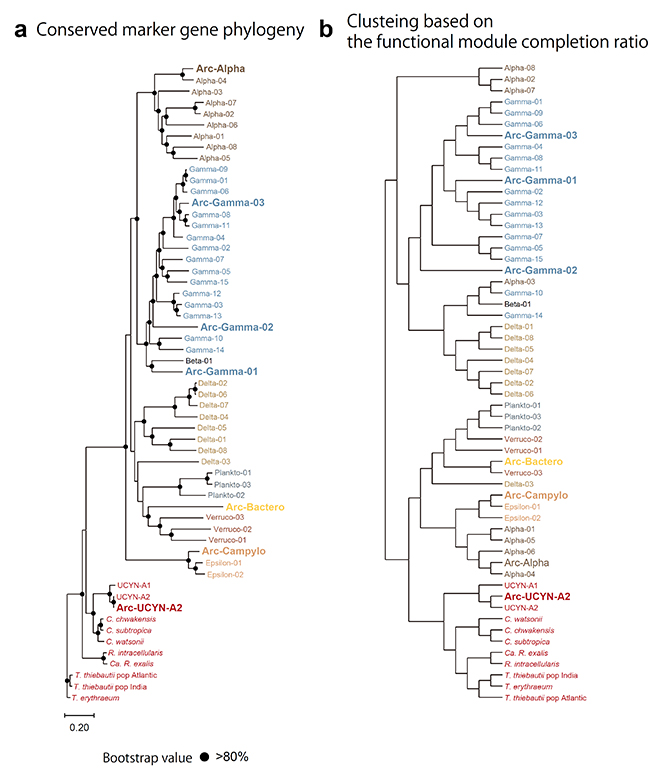Metagenome-assembled genome of N2-fixing bacteria from the Arctic Ocean: Survival strategies of endemic and cosmopolitan species
24 May, 2023

Takuhei Shiozaki# (Atmosphere and Ocean Research Institute, The University of Tokyo)
Yosuke Nishimura# (Japan Agency for Marine-Earth Science and Technology)
Susumu Yoshizawa (Atmosphere and Ocean Research Institute, The University of Tokyo)
Hideto Takami (Atmosphere and Ocean Research Institute, The University of Tokyo)
Koji Hamasaki (Atmosphere and Ocean Research Institute, The University of Tokyo)
Amane Fujiwara (Japan Agency for Marine-Earth Science and Technology)
Shigeto Nishino (Japan Agency for Marine-Earth Science and Technology)
Naomi Harada (Atmosphere and Ocean Research Institute, The University of Tokyo)
#Takuhei Shiozaki and Yosuke Nishimura should be considered joint first author
N2 fixation is a globally biogeochemically important process. What has not yet been determined is how N2-fixing bacteria (diazotrophs) are able to inhabit N-rich polar oceans. Here we answered this question based on diazotroph genomes constructed from metagenomic data from samples collected in the Arctic Ocean and our own global marine metagenomic database. We found cosmopolitan diazotrophs that are distributed both in the Arctic Ocean and the lower latitudes that have the potential for cold adaptation. In contrast, we also found Arctic-endemic diazotrophs, which have specific genes that help them adapt to the Arctic environment. This study provides a new perspective on the global distribution and ecology of marine diazotrophs.
N2 fixation is the process by which specialized prokaryotes (diazotrophs) convert N2 gas to ammonia, and is a major source of reactive nitrogen in the ocean. It has long been thought that N2 fixation occurs mainly in the nitrogen (N)-depleted tropical and subtropical regions where cyanobacterial diazotrophs are prevalent. However, recent studies have demonstrated that N2 fixation occurs even in the N-rich polar regions and thus is a global process. Information on diazotrophs in the polar oceans is currently limited to the nifH sequence, which encoding the nitrogenase reductase subunit, and thus the physiological and ecological characteristics of polar diazotrophs are not yet known.
This study successfully reconstructed the diazotroph genomes from metagenomic data in the Arctic Ocean, including that of cyanobacterium UCYN-A (Candidatus ‘Atelocyanobacterium thalassa’), which is one of the major diazotrophs in global ocean. One of the metagenome-assemblage genomes (MAGs) is taxonomically classified to Bacteroidota at the phylum level, which have not been reported thus far from the marine water column, indicating that diazotrophs are more diverse in the ocean than previously thought.
We examined the relative abundance of each diazotroph MAG in a global metagenome database. The results show that there are two distribution patterns: those that mainly occurs in the Arctic Ocean and those that occurs both in the Arctic Ocean and the low-latitude, suggesting the existence of Arctic-endemic and cosmopolitan diazotrophs (Fig. 1). The full-length nifH sequence of Arctic UCYN-A is distinct from that of low-latitude UCYN-A, thus the Arctic UCYN-A could be Arctic-endemic.

Fig. 1 Depth-resolved abundance of Arctic-endemic and cosmopolitan diazotrophs across the global oceans (an example)
The area of each circle is proportional to its indicated abundance. Sampled depths are divided into ≤200, 200–1000, and ≥1000m, and are indicated in red, black open circle, and blue, respectively. Arc-Bactero is mainly found around the Arctic Ocean, while Arc-Alpha is found not only in the Arctic Ocean but also in low latitudes and the Southern Ocean.
Arctic-endemic diazotrophs do not differ markedly from other diazotrophs in terms of usage of amino acids and codons and genome-wide function (Fig. 2), but they have unique gene sets that other diazotrophs do not have. Specifically, Gammaproteobacterial diazotrophs have diverse aromatics degradation genes and numerous glycosyltransferase genes, and Arctic UCYN-A has a DNA repair gene, which can be used for adaptations to Arctic-specific conditions. In addition, some of the Arctic endemics occur predominantly in the viral fraction (<0.2µm) of metagenomic data, which are expected to have a very small cell size, indicating that current methods cannot capture their N2 fixation.

Fig. 2 a. phylogenetic tree based on concatenated sequences of a set of marker genes conserved in the MAGs. b. hierarchical clustering analysis of MAGs based on the pattern of completion ratios of functional modules as calculated by the Genomaple system (https://maple.jamstec.go.jp/maple/maple-2.4.0/![]() ). Label colors represent phylum- or class-level taxonomy. Bolded name with Arc- are diazotroph MAGs from Arctic Ocean, and the rest are diazotroph genomes from lower latitudes. The conserved maker gene-based phylogenetic tree forms various clusters categorized into every phylum or class in the case of Proteobacteria. Arctic diazotroph MAGs do not form their own cluster in b, indicating that they do not possess common functional traits that can distinguish them from those from lower latitudes.
). Label colors represent phylum- or class-level taxonomy. Bolded name with Arc- are diazotroph MAGs from Arctic Ocean, and the rest are diazotroph genomes from lower latitudes. The conserved maker gene-based phylogenetic tree forms various clusters categorized into every phylum or class in the case of Proteobacteria. Arctic diazotroph MAGs do not form their own cluster in b, indicating that they do not possess common functional traits that can distinguish them from those from lower latitudes.
We first found cosmopolitan diazotrophs that were distributed all over the world. These cosmopolitan species are mostly non-cyanobacterial diazotrophs. Detailed examination of their genome revealed that they commonly have cspA gene encoding cold-inducible RNA chaperone, which is a protein involved in maintaining RNA structure at low temperature, and is known as one of the representative proteins shared among microbes in cold environments. Therefore, the cosmopolitan diazotrophs have the potential for cold adaptation. In the ocean, cold environments exist not only in the polar regions, but also in the deep sea. Most microbes except phototrophs can occur from the surface to the deep sea, and thus it is not surprising that non-cyanobacterial diazotroph with low-temperature adaptability can be cosmopolitan species. On the other hand, most cyanobacterial diazotrophs do not have the cspA gene. Cyanobacteria can grow only in the euphotic layer (<200m), as they need to perform photosynthesis, and cyanobacterial diazotrophs generally prefer high-temperature (>20°C). Therefore, cyanobacterial diazotrophs are low-latitude endemics.
This study found that the biogeographic distribution of diazotrophs follows one of three patterns: low-latitude-endemic, Arctic-endemic, and cosmopolitan (Fig. 3). The endemic species can be highly vulnerable to environmental change. The Arctic Ocean is one of the most rapidly changing oceans on Earth, as exemplified by sea ice reduction. This study not only provide a new perspective on the global distribution and ecology of marine diazotrophs, but will also contribute to our understanding of current and possible future Arctic N2 fixation.

Fig. 3 Schematics of global distribution of Arctic-endemic, cosmopolitan, and low-latitude endemic diazotrophs
This study was financially supported by the Japan Society for the Promotion of Science (JSPS) KAKENHI Grant JP15H05712, JP19H04263, JP21H03583, JP22K15089, JP22H05714, and JP23H05411, Japan Science and Technology Agency (JST) ACT-X Grant JPMJAX21BK, Arctic Challenge for Sustainability II (ArCS II) of the Ministry of Education, Culture, Sports, Science and Technology, and the FSI project “Ocean DNA: Constructing “Bio-map” of Marine Organisms using DNA Sequence Analyses” from The University of Tokyo.
Reference
Journal: The ISME Journal
Title of original paper: Distribution and survival strategies of endemic and cosmopolitan diazotrophs in the Arctic Ocean
Authours: Takuhei Shiozaki#*, Yosuke Nishimura, Susumu Yoshizawa, Hideto Takami, Koji Hamasaki, Amane Fujiwara, Shigeto Nishino, Naomi Harada
DOI: https://doi.org/10.1038/s41396-023-01424-x![]()
Media contact
Takuhei Shiozaki
E-mail: shiozaki[at]g.ecc.u-tokyo.ac.jp
Yosuke Nishimura
E-mail: nishimuray[at]jamstec.go.jp
![]()



